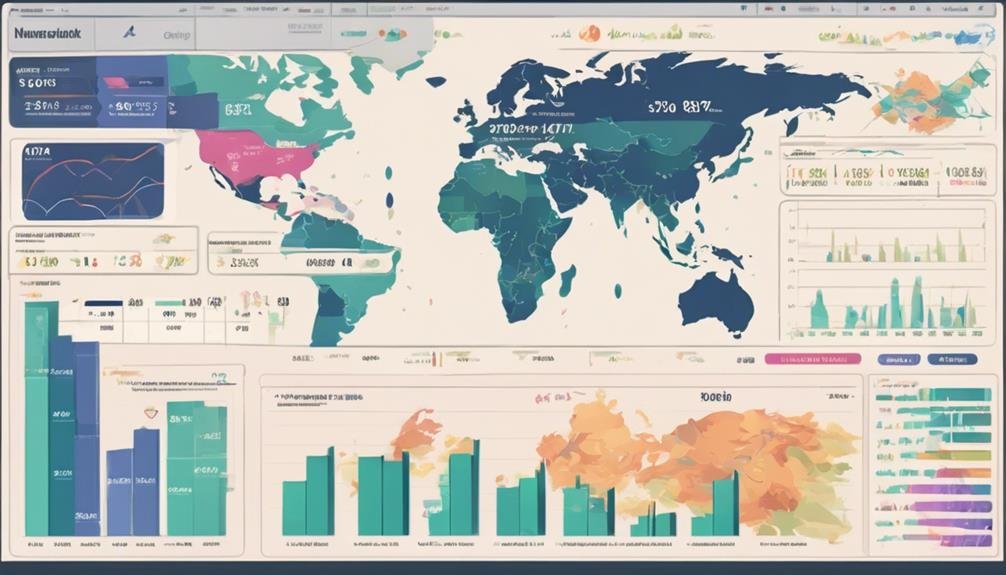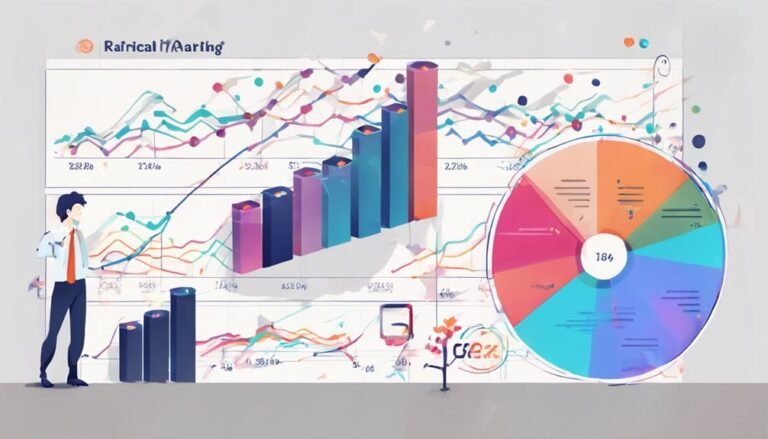What Role Does Data Analytics Play in Sales Strategy?
Data analytics enhances your sales strategy by providing vital insights, improving decision-making, and boosting revenue through data-driven methods. It improves sales forecasting accuracy with predictive models and trend analysis. By optimizing customer segmentation, you can customize marketing efforts and increase engagement. Personalized sales and marketing approaches based on customer data lead to greater loyalty. Identifying cross-selling opportunities and streamlining the sales process using automation are essential for success. Additionally, leveraging data for improving team performance and making informed decisions give you a competitive edge. Embrace data analytics to realize the full potential of your sales strategy.
Key Takeaways
- Enhances sales forecasting accuracy through predictive modeling.
- Optimizes customer segmentation strategies for tailored marketing.
- Personalizes sales and marketing efforts based on data insights.
- Identifies cross-selling and upselling opportunities using customer data.
- Improves sales team performance with data-driven insights.
Enhancing Sales Forecasting Accuracy
To enhance sales forecasting accuracy, incorporate advanced data analytics techniques into your sales strategy. By leveraging predictive modeling, you can greatly increase the precision of your sales forecasts. Predictive modeling uses historical data, statistical algorithms, and machine learning techniques to identify patterns and predict future outcomes.
This approach enables you to make informed decisions based on data-driven insights rather than relying solely on intuition or guesswork.
By incorporating predictive modeling into your sales strategy, you can identify trends, anticipate customer behavior, and adjust your approach accordingly. This proactive approach allows you to optimize your sales efforts, allocate resources more effectively, and capitalize on emerging opportunities.
Additionally, predictive modeling can help you anticipate market fluctuations, identify potential risks, and develop contingency plans to mitigate them.
Optimizing Customer Segmentation Strategies
To optimize your customer segmentation strategies effectively, you must employ advanced segmentation analysis techniques to identify distinct customer groups based on various attributes and behaviors.
By doing so, you can tailor your marketing efforts towards targeted campaigns that resonate with specific segments, enhancing the overall effectiveness of your sales strategy.
This precision in customer segmentation allows for a more personalized approach, leading to increased customer engagement and higher conversion rates.
Segmentation Analysis Techniques
Implementing advanced segmentation analysis techniques can greatly enhance sales strategies by optimizing customer segmentation strategies for targeted marketing efforts. By leveraging customer profiling and market segmentation, businesses can tailor their approaches to different customer segments more effectively. Utilizing techniques such as demographic segmentation, psychographic segmentation, and behavioral segmentation enables companies to understand their customers better and deliver more personalized experiences. This, in turn, increases customer satisfaction and loyalty, driving sales growth. Through segmentation analysis, businesses can identify high-potential customer groups, allocate resources efficiently, and develop tailored marketing strategies that resonate with specific segments. The table below illustrates the different segmentation analysis techniques that can be employed:
| Segmentation Technique | Description |
|---|---|
| Demographic Segmentation | Segments based on age, gender, income, etc. |
| Psychographic Segmentation | Segments based on lifestyle, values, beliefs, etc. |
| Behavioral Segmentation | Segments based on purchasing behavior, usage patterns, etc. |
Targeted Marketing Campaigns
Optimizing customer segmentation strategies through targeted marketing campaigns enhances sales effectiveness by tailoring approaches to specific customer segments. Customer profiling and market analysis are essential in understanding the diverse needs and preferences of different customer groups.
By leveraging behavioral targeting techniques, businesses can create personalized campaigns that resonate with specific segments, increasing the likelihood of conversion. Campaign optimization further refines these strategies by analyzing data insights to improve targeting precision and message relevance.
This approach not only maximizes the impact of marketing efforts but also fosters stronger customer relationships. By aligning marketing initiatives with the interests and behaviors of distinct customer segments, companies can drive engagement, loyalty, and ultimately, sales growth.
Personalizing Sales and Marketing Efforts
When personalizing sales and marketing efforts, it's important to focus on targeted customer segmentation and tailored communication strategies.
By utilizing data analytics, you can identify specific customer needs and preferences, enabling you to create more effective and personalized sales approaches to enhance customer engagement and satisfaction.
This approach can lead to higher conversion rates and increased customer loyalty, ultimately driving the success of your sales strategy.
Targeted Customer Segmentation
To enhance sales and marketing effectiveness, leveraging targeted customer segmentation is essential in personalizing your strategies and approaches. Customer profiling and market analysis are key components of this process.
By analyzing behavior patterns and market trends, you can divide your customer base into distinct segments based on similarities in purchasing behavior, demographics, or preferences. This segmentation allows you to tailor your sales and marketing efforts to cater to the specific needs and interests of each group.
Understanding the unique characteristics of different customer segments enables you to design more targeted campaigns, offer personalized recommendations, and ultimately increase the effectiveness of your sales strategy. Effective targeted customer segmentation is a powerful tool in driving sales growth and improving customer satisfaction.
Tailored Communication Strategies
Implementing tailored communication strategies is essential in personalizing sales and marketing efforts to enhance customer engagement and drive conversion rates. By analyzing customer data, you can create customized messages that resonate with individual preferences and behaviors. This approach increases the likelihood of capturing the attention of potential buyers and fostering a deeper connection with existing customers.
Tailored communication strategies not only demonstrate a genuine understanding of your audience but also showcase your commitment to meeting their specific needs. Through personalized interactions, you can enhance sales effectiveness by delivering targeted content that addresses customer pain points and motivates them to take action. Ultimately, prioritizing tailored communication strategies can have a significant impact on customer engagement and contribute to improved sales performance.
Identifying Cross-Selling and Upselling Opportunities
How can data analytics be leveraged to identify potential cross-selling and upselling opportunities within a sales strategy? By analyzing customer data, you can uncover valuable insights that enable you to suggest complementary products or upgrades, ultimately boosting sales and enhancing customer satisfaction.
Here are three key ways data analytics can help you identify these opportunities:
- Product Bundling Opportunities: Data analytics can reveal which products are often purchased together, allowing you to create strategic bundles that entice customers to buy more.
- Leveraging Customer Insights: By analyzing customer behavior and preferences, you can tailor your cross-selling and upselling suggestions to match their needs and interests effectively.
- Predictive Analytics for Sales Opportunities: Utilizing behavioral patterns identified through data analysis, you can predict when a customer may be ready for an upsell, enabling you to approach them at the right moment with a compelling offer.
Improving Sales Team Performance
Enhance your sales team's performance by leveraging data-driven insights and targeted training initiatives. Team motivation is important for driving sales success. Utilize performance metrics to identify top performers and areas needing improvement. By analyzing data on individual and team performance, you can provide tailored coaching techniques to enhance skills and boost results.
Coaching techniques play a significant role in refining sales strategies and improving overall performance. Implement personalized coaching sessions based on data insights to address specific skill development needs. Utilizing data analytics allows you to identify patterns in successful sales approaches, enabling you to replicate these strategies across the team.
Furthermore, continuous training and skill development are essential for keeping your sales team competitive and adaptable in a dynamic market. By leveraging data to pinpoint areas for improvement, you can tailor training programs to address specific weaknesses and enhance overall sales performance. Empower your team with the tools and knowledge they need to excel, driving success and growth in your sales operations.
Minimizing Customer Churn and Attrition
To reduce customer churn and attrition effectively, analyze customer behavior patterns and feedback to identify key areas for improvement. Understanding what drives customers away and taking proactive steps to enhance their experience can greatly boost customer retention and loyalty.
Here are three key strategies to prevent customer loss and increase engagement:
- Personalized Communication: Tailoring your communication based on customer preferences and past interactions can help create a more personalized experience, making customers feel valued and understood.
- Proactive Issue Resolution: Anticipating potential problems through data analysis and addressing them before they escalate can demonstrate your commitment to customer satisfaction, building trust and loyalty.
- Rewarding Loyalty: Implementing loyalty programs or offering exclusive deals to long-term customers can incentivize repeat business and strengthen the bond between the customer and your brand.
Streamlining Sales Process Efficiency
To optimize sales effectiveness, a focus on streamlining the sales process for efficiency is essential in maintaining a competitive edge in the market. Process automation plays a vital role in simplifying repetitive tasks, allowing your sales team to focus on high-value activities. By automating tasks like data entry, follow-up emails, and lead scoring, you can increase productivity and reduce the likelihood of errors.
Data visualization tools enable you to track performance metrics in real-time, providing valuable insights into sales activities and outcomes. Visual representations of data allow for quick analysis of trends, identifying bottlenecks or areas for improvement. This real-time visibility empowers you to make data-driven decisions promptly, optimizing your sales process for maximum efficiency.
Incorporating performance tracking mechanisms ensures that you can monitor key performance indicators effectively. By setting clear goals and tracking progress, you can identify underperforming areas and take proactive steps to address them. Continuously refining your sales process based on performance data is vital for enhancing sales efficiency and achieving sustainable growth.
Enhancing Competitive Intelligence
By leveraging data analytics, you can gain a competitive edge by enhancing your understanding of market dynamics and competitors' strategies. This enhanced competitive intelligence is pivotal for shaping your sales strategy effectively.
Here are three key ways data analytics can help you achieve this:
- Market Research: Data analytics allows you to explore deeply into market trends, customer preferences, and emerging opportunities. By analyzing vast amounts of data, you can identify niche markets, understand customer behavior, and predict future demands more accurately.
- Competitive Analysis: Through data analytics, you can track your competitors' activities, pricing strategies, product launches, and customer interactions. This information enables you to benchmark your performance, identify areas for improvement, and respond swiftly to competitive threats.
- Strategic Decision-Making: Armed with insights from data analytics, you can make informed decisions regarding product development, pricing adjustments, and marketing campaigns. This data-driven approach ensures that your sales strategy remains agile, adaptive, and aligned with market realities.
Driving Data-Driven Decision-Making
Leveraging data analytics in your sales strategy empowers you to make informed decisions based on concrete insights and trends. Making data-driven decisions enhances your sales effectiveness by allowing you to align your strategies with what the data reveals. By harnessing the power of data analytics, you can optimize your sales approach, identify opportunities for growth, and address potential challenges proactively. Here is a table illustrating how data-driven decision-making can impact sales effectiveness:
| Benefits of Data-Driven Decision-Making |
|---|
| Improved Sales Forecasting |
| Enhanced Customer Segmentation |
| Personalized Marketing Strategies |
| Real-Time Performance Tracking |
Embracing data-driven decisions gives you a competitive edge in the market, enabling you to adapt quickly to changing trends and customer preferences. This analytical approach not only streamlines your sales processes but also fosters a culture of continuous improvement within your sales team.
Conclusion
To sum up, data analytics plays a pivotal role in shaping sales strategy by providing valuable insights and enabling informed decision-making.
As the saying goes, 'knowledge is power,' and leveraging data analytics empowers businesses to optimize their sales processes, improve customer relationships, and stay ahead of the competition.
By harnessing the power of data, organizations can drive growth, enhance efficiency, and achieve sustainable success in the dynamic world of sales.







